
TOP-WORKING LYCHEES - THE RESULT
SCIENTIFIC NAME: Litchi chinensis
FAMILY: Sapindaceae
The article 'Top Working Lychees' that appeared in the RFCA Newsletter No. 80 of May, 1993, described a top-working project aimed at quickly converting large, unmanageable Tai So Trees over to the new super variety Fay Zee Siu. That article must be read in conjunction with this one to get the full story.
So how did it all work out?
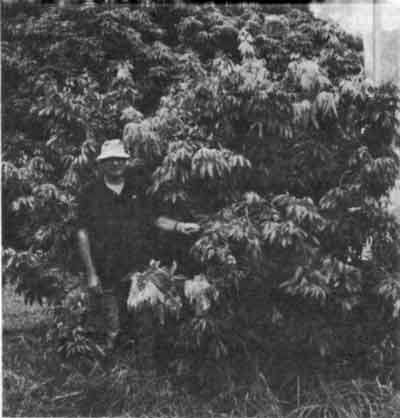 | 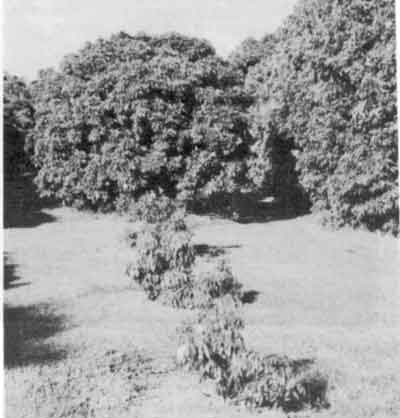 |
| Picture 1. A tree one year and ten months after Top-Working Fay Zee Siu onto Tai So. | Picture 2. The slower growth of single trees planted back into old tree sites. These are older than the tree in Picture 1. |
Only a bunch or two of fruit was picked off the Top-Worked trees so don't expect much fruit for the first two years at any rate. However, it will be interesting to see if any fruit is produced in the third year. But don't expect miracles!
IS TOP WORKING EXPENSIVE?
CAPITAL COST
Yes, it is expensive in planting material. The capital cost is high but the benefits could outweigh this cost eventually. The previous article in Newsletter No. 80 describes how four or five potted marcots were approach grafted to the suckers around each stump. That is $80-$100 per stump at $20 a potted marcot. There is no gain without pain!! Cheaper if you marcot your own trees, of course.
REPLANTING VS TOP-WORKING
What must also be taken into account is the slower growth and longer time involved to get trees into production when replanting into old tree sites.
TIME IS MONEY!
Consider the cost of your time over the number of years it takes to get such trees into bearing. The cost of irrigating, fertilizing, weed control, spraying and mowing, etc., is much the same, but the lag time to get the new trees into production should be considerably reduced by Top-Working instead of replanting. Furthermore, earlier yields from Top-Worked trees should be higher, because of the larger tree size and increased vigour.
WHY SO MUCH VIGOUR?
Why are the Top-Worked trees so vigorous? Partly, perhaps, because of the vigorous Fay Zee Siu variety and partly, perhaps, because of the extra vigour imparted to it by the massive Tai So root system now around 20 years old. But I think it is also very largely due to the high population of actively-growing mycorrhiza fungi in the soil on the old Tai So root system.
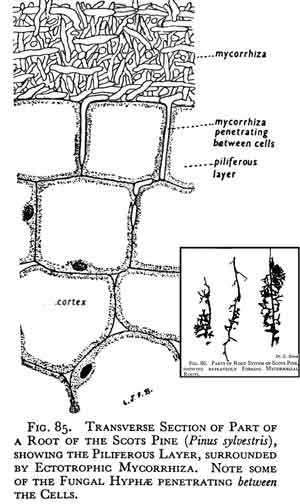
MYCORRHIZA
What is mycorrhiza? It is a beneficial fungus which lives on the roots of certain trees. The fungus is supplied with nutrients by the tree and in return it helps the tree to absorb moisture and nutrients from the soil.
This is known as a symbiotic relationship, each helps the other to the mutual benefit of both. One cannot live without the other.
Oh the wonders of nature! I believe the Lychee to be a tree highly dependant on its mycorrhiza for optimum growth and cropping.
Mycorrhiza has been observed on Lychee roots, but unfortunately I have no picture. But here are two of this beneficial fungus on Pine tree roots to show what it looks like.
By Top-Working in the manner described in the Newsletter No. 80 we take full advantage of the presence of this mycorrhiza.
WHEN ABSENT GROWTH MAY BE SLOWER
Now look carefully at Picture 2. These trees were planted back into old tree sites, but only after the trees were removed and the sites fallowed for a while before being replanted. In other words, any roots and their mycorrhiza left in the soil were dead by the time the new trees were planted. Some mycorrhiza die very quickly once the host tree is removed. Hence the new trees tended to struggle initially to get established. The fact that they are of a less vigorous variety makes them look even worse when compared with the Top-Worked trees.
THE EFFECT ON VIGOUR
Picture 3 illustrates what I believe to be the immediate effect of mycorrhiza on initial growth. Notice that the growth from the approach graft in the middle is not as vigorous as the two branches arising from below the graft.
In this illustration the potted marcot was planted in the ground next to the stump and approach grafted onto a sucker.
The Tai So stump and its root system, kept alive by all the suckers, would have had plenty of active mycorrhiza fungi in the soil. These would rapidly colonise the roots of the Fay Zee Siu marcot and immediately help it to absorb nutrients and moisture. Hence the rapid growth from below the graft while the graft was becoming established.
Well, that's my theory anyway!
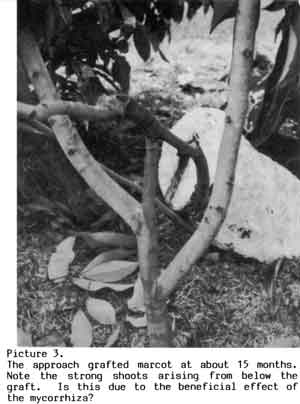
RECOMMENDATION
One occasionally sees marcots which die some time after potting up, even though they grew initially, and also potted marcots which survived planting in the orchard, but died later on even though good care was taken of them.
Could this be partly due to the lack of mycorrhiza fungus in the potting mix and/or lack of the fungus in the orchard soil?
Would establishment and growth in the pot and later on in the orchard be improved if the mycorrhiza was present right from the start?
Personally I think it would and I would recommend as follows:
Scrape away the leaves from under old established Lychee trees and dig out the topsoil and fibrous roots. Add about 20% of this to the potting mix when potting up rooted marcots. Also put a couple of handfuls per hole when planting out. Mixing soil with the peat moss when marcotting may also be beneficial. Always use the soil fresh from under the tree, don't store it for any length of time or the mycorrhiza may deteriorate.
IS THIS PRACTICAL?
I realize the practicality of doing this on a large scale is perhaps doubtful from a nurseryman's point of view. It may only be worthwhile if one is experiencing high numbers of deaths in the nursery or loss of trees after planting. For small numbers, it might be worth giving it a go.
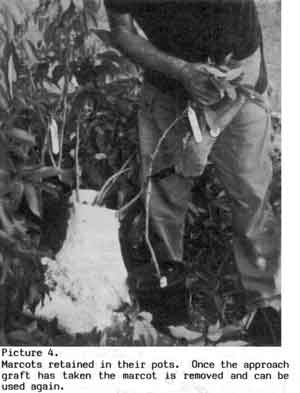
A NOT-SO-GOOD ALTERNATIVE
As can be seen from Picture 4, instead of planting the Fay Zee Siu marcot in the ground, the pot on the right was placed on the ground next to the stump and the pot on the left on top of the stump.
The advantage here is that once the approach graft has taken, the marcot is cut off below the graft and can then be used again elsewhere. As it would be fairly pot-bound by now it would probably be better to plant it in the ground next time. Tease out the roots before planting.
The main disadvantage of this method, which I have observed, is that it is more difficult to keep all the pots watered, especially if a great number of trees are being Top-Worked.
If not kept adequately watered, you can expect some graft failures. For a good take, they really should be watered by hand, individually.
Putting a sprinkler above the tree may work but the dense sucker foliage tends to deflect the water to some extent. Pots need to be level, of course, and some may need to be placed on boxes or bricks to bring them up to the sucker for grafting.
FEED THE POTS
If the potting mix is very porous, as most peat-based mixes are, nutrients tend to rapidly leach out. Perhaps it would be better to mix soil with the peat as previously described, but at a higher rate, to act as a buffer if this method of Top-Working is to be employed. Top-dress each pot regularly with a soluble fertilizer to keep the marcot actively growing for a good take.
In my opinion, if not given good care and attention, this is not such a good method as planting the marcot in the ground. As it is isolated from the soil, it misses out on what I think is the beneficial effect of the abundant mycorrhiza in the soil around the stump. The resulting tree tends to be smaller initially.
EXPERIMENTAL GRAFT FAILURES
Ah yes, we must always talk about the failures as well as the successes. Thus we learn by practical experience!
As described in the original article in the May 1993 Newsletter, I tried out two alternative methods of Top-Working: Cleft grafting and Chip budding.
Cleft grafting was a complete failure, all the scions died, so I guess we can forget that method.
Out of about a dozen Chip buds, only two grew. As with all Chip budding, the take can be considerably improved providing the bud wood is especially grown for the job.
I took my bud wood off mature cropping trees, which is not the way to go, but I had no choice. Just wandering around the orchard snipping shoots off here and there is definitely not on! I found it very hard to find the ideal wood.
Bud wood for Chip budding must be produced on young, vigorous bushes which are kept hard-pruned and well-fertilized. Hedge-pruned bushes, in fact. This produces vigorously flushing wood which is taken off when it still has some green colour and when the axillary buds are nice and prominent. It is impossible to find this sort of wood on large fruiting trees in any quantity.
Unless you can get this sort of wood, forget about budding. However, if you can, then this could be a promising alternative method of top-working as it is quick and easy to do.
THE BEST METHOD SO FAR
No doubt about it. Approach grafting with potted marcots is 100%. So, in my opinion, if you want to Top-Work either old or young trees over to a better variety, and if you want a big tree quickly, then that is the way to go as described in the RFCA Newsletter No. 80 of May 1993.
COMPATIBILITY
Watch compatibility. Not all varieties are compatible with each other when grafted. Apparently, from what I have read, early vigorous varieties are compatible with each other. Similarly with mid-season and with late, slow-growing varieties. But there is incompatibility between these three groups. See the DPI for more information on that. But we do know that Fay Zee Siu is compatible when grafted onto Tai So. I will keep you posted on how the Top-Worked trees have performed in the future.
So, if you want to give it a go, then the best of luck!! !
DATE: May 1995
* * * * * * * * * * * * *
